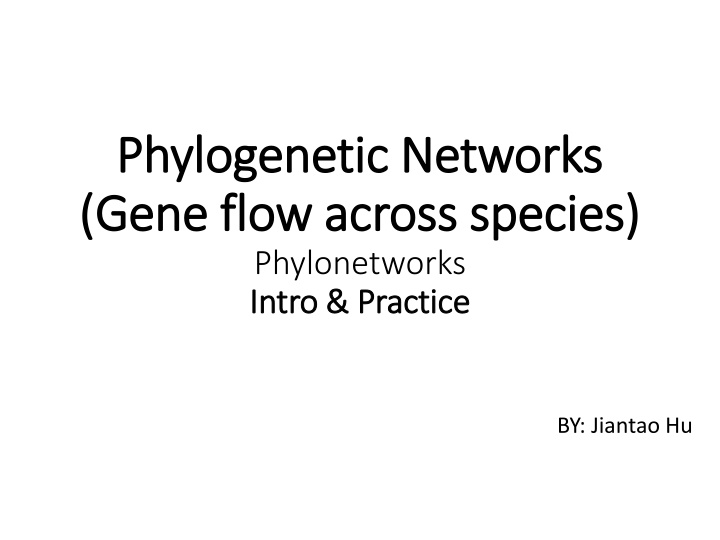
Phylogenetic Networks and Gene Flow Across Species
Explore the concept of phylogenetic networks, the incorporation of hybrid edges into phylogenetic trees, and the reasons behind their existence such as horizontal introgression, interspecific recombination, and hybridization. Learn how to distinguish between reticulation and incomplete lineage sorting through methods like ABBA-BABA D-statistics and SNaQs. Dive into the practice of phylogenetic analysis, including parameter identification using the SNaQs method.
Download Presentation

Please find below an Image/Link to download the presentation.
The content on the website is provided AS IS for your information and personal use only. It may not be sold, licensed, or shared on other websites without obtaining consent from the author. If you encounter any issues during the download, it is possible that the publisher has removed the file from their server.
You are allowed to download the files provided on this website for personal or commercial use, subject to the condition that they are used lawfully. All files are the property of their respective owners.
The content on the website is provided AS IS for your information and personal use only. It may not be sold, licensed, or shared on other websites without obtaining consent from the author.
E N D
Presentation Transcript
Phylogenetic Networks Phylogenetic Networks (Gene flow across species) (Gene flow across species) Phylonetworks Intro & Practice Intro & Practice BY: Jiantao Hu
What is Phylogenetic networks? A phylogenetic tree with added hybrid edges hybrid edges Incorporate organisms to the tree of life in parts that are more net-like than tree-like
Why there are Phylogenetic networks Cases 1: Horizontal introgression: Network cases Observed gene trees Species trees
Cases 2: Interspecific recombination:
Cases 3: Hybridization:
Phylogenetic networks or ILS? Either Reticulation or ILS account for the gene tree discordance How to distinguish them? ABBA-BABA D-statistics analysis: allele-base (SNPs data) Species Networks applying Quartets (SNaQs) method: maximum pseudolikelihood-base (gene trees or quartet CF value)
ABBA-BABA D-statistics analysis: based on the frequencies of discordant SNP genealogies in a four-taxon tree: O+[C+(B+A)] *D: a way to test the correctness of a hypothetical genetic relationship between the four groups *ABBA: SNPs where A retains the outgroup (O) allele and B and C share the derived allele *BABA :SNPs where A and C share the derived allele and B retains the outgroup(O) allele According to the IUA model: If there is no gene flow, ABBA=BABA, D = 0 D>0, gene flow between B and C D<0, gene flow between A and C
SNaQs method Parameters N topology , t (branch length), (inheritance values) pseudolikelihood model would be identifiable if two different combinations quartet CFs of parameters (N ; t; )
Practice 1. Install PhyloNetworks & PhyloPlots (Under Julia) $ using Pkg $ Pkg.add("PhyloNetworks") $ Pkg.add("PhyloPlots") 2. Read Gene trees $ using PhyloNetworks $ raxmltrees=joinpath("raxmltrees.tre") $ genetrees = readMultiTopology(raxmltrees)
3. Generate Table CF $ q,t = countquartetsintrees(genetrees) $ df = writeTableCF(q,t) $ using CSV $ CSV.write("tableCF.csv", df) $ raxmlCF = readTableCF("new_tableCF.csv") Check Headers!!!
3. Run SNaQ with scripts $ nohup julia runSNaQ.jl {$m} {$i} > h1.log & {$m} numbers of hybrid edges {$i} numbers of replicates
4. Finding the best h (reticulation events number) and plotting $ scores = [net0.loglik, net1.loglik, net2.loglik, net3.loglik] $ hmax = collect(0:3) $ R"plot"(hmax, scores, type="b", ylab="network score", xlab="hmax", col="blue");
5. Output the best tree and reroot $ using PhyloNetworks $ net = readTopology("net1_5runs.out") $ writeTopology(net,"bestnet_h1.tre") $ net1 = readTopology("bestnet_h1.tre") $ rootatnode!(net1,"C") $ net1_reroot = rootatnode!(net1,"C") $ writeTopology(net1_reroot) $ writeTopology(net1_reroot, "net1_reroot.tre") 6. Result network visualization $ using PhyloPlots $ using RCall $ imagefilename = "../assets/figures/snaqplot_net1_2.svg" $ R"svg"(imagefilename, width=4, height=3) $ R"par"(mar=[0,0,0,0]) $ plot(net1_reroot, showgamma=true, showedgenumber=true); $ R"dev.off()"; # wrap up and save image file
More on: https://crsl4.github.io/PhyloNetworks.jl/latest/man/snaq_plot/
Gene flow within population Gene flow within population Treemix Treemix Intro & Practice Intro & Practice
How Treemix works: SNP data allele frequency Real value ML tree If R.V < Est.V Gene flow exist Tree topology Estimate value
Let's practice! Step 1: Vcf data to tped/tfam Family ID Idv. ID Father Info. Mother Info. Sex Info. Phenotype Info.
Step 3: Calculate allele frequency Important for non- human sample gzip
Step 4: generate input file for Treemix Step 5: run Treemix
